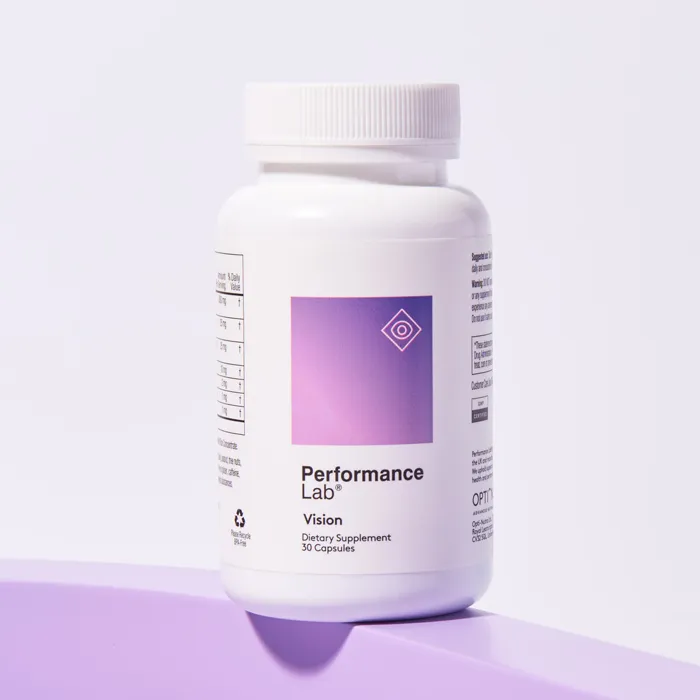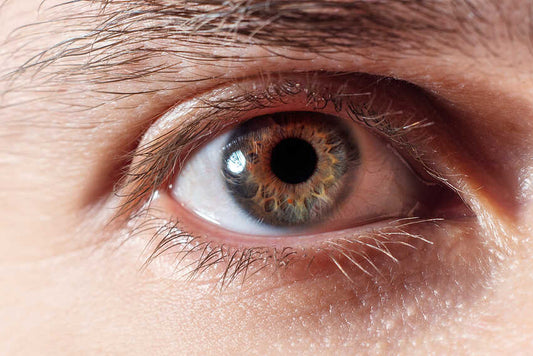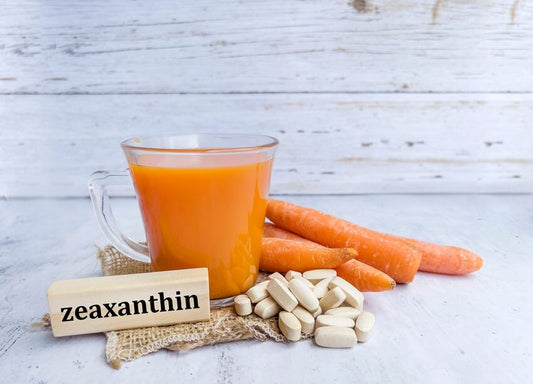At first glance, you may think we're talking about blueberries, but nope, it's bilberries!
Legend has it that RAF pilots during the Second World War consumed bilberries to sharpen their night vision for missions at night. However, as cool and plausible as this seems, there is little medical evidence to suggest such a benefit 1.
But regardless of whether they improve night vision or not, bilberries have been used in folklore and traditional medicine to treat various health conditions, maintain health, and prevent states of disease.
Let's take a deep dive into bilberry extract, why it's beneficial for your health, where you can find it, and how much is enough to elicit a favorable effect.
Key Takeaways
- Bilberry is a close relative of blueberry that is rich in anthocyanins, potent antioxidants that help protect delicate eye tissues from oxidative stress.
- Research links bilberry extract to benefits such as stronger retinal capillaries, better dark adaptation, and slower progression of age-related eye changes.
- Bilberry’s anthocyanins may also support wider health by offering genoprotective, cardioprotective, anti-inflammatory, and potential anti-diabetic effects.
- Supplement studies commonly use standardized bilberry extract in the range of about 120–400 mg daily, with lower doses still useful when stacked with other eye antioxidants.

What Is Bilberry?
A close relative to blueberries, bilberries are a Eurasian species of low-growing shrubs that are part of the Vaccinium genus of plants that produce dark, edible, blue-colored berries.
If you've never seen the name bilberry before, it's also sometimes referred to as whortleberry, huckleberry, or European blueberries.
While they're commonly eaten in things like jams, juices, or pies, they're also widely available in powders, juice concentrates, and other extracts.
Both bilberries and blueberries contain a diverse range of anthocyanins, specifically anthocyanidins, including delphinidin and cyanidin glycosides 2, 3.
Where bilberries differ from blueberries is on the inside—blueberry pulp is light green, sometimes white, whereas bilberry pulp is red or purple.
The high anthocyanin content is largely responsible for this deep color that may stain the fingers, lips, and tongue of those consuming it 3.
Bilberry and Eye Health
Here's the part you'll want to focus on: the science behind why you should take bilberry extract if you want to maintain (or even improve) eye health.
It's a potent antioxidant
The rich concentration of antioxidants is generally one of the trademark benefits of bilberries.
Antioxidants are plant compounds that help neutralize free radicals in the body capable of damaging important cellular components, which can lead to the development of an array of diseases.
Reactive oxygen species are typically present in the body in very low concentrations.
Under normal circumstances, the body produces and uses its natural antioxidant defence system, including vitamin C, vitamin E, glutathione, and naturally occurring enzymes to scavenge these free radicals and neutralize them.
However, when there is an excessive accumulation of ROS, they can alter the nature of lipids and proteins, ultimately causing cellular dysfunction 4.
Prolonged damage due to high levels of free radicals in tissues of the eye may cause irreversible damage. That's where antioxidants become important.
Berries, including bilberries, are particularly high in antioxidants with mean levels averaging 48.3mml per 100g of berries 5.
And studies show that higher antioxidant status may reduce the risk of many chronic degenerative diseases 6.
Anthocyanins
Of the antioxidant compounds, anthocyanidins are the most abundant.
They are the polyphenolic flavonoid compounds responsible for giving bilberry its blue/black color and high antioxidant content, as well as the possible key bioactives attributed to its many health benefits.
The anthocyanins are found mainly in the bilberry's skin, and damage to the skin during harvesting can reduce anthocyanin content. The berry's ripeness may also alter concentrations.
On top of their potent antioxidant capacity, anthocyanins have also been shown to stabilize DNA, modify adipocyte (fat cell) gene expression, improve insulin secretion and sensitivity, and have antiapoptotic, anti-inflammatory, and antibacterial effects 7.
Ocular Health
Some of the major causes of blindness are cataracts, glaucoma, macular degeneration, retinoblastoma, and retinopathy.
Infections and damage to the eye may also contribute to blindness 4. While some of these factors are inherited, others may be preventable through proper nutrition.
Several studies have shown bilberry extract to elicit positive effects on eye health, including improving retinal abnormalities, enhancing capillary resistance, slowing the progression of lens opacity and myopia, and improving dark adaptation 7.
One study, specifically, of 50 patients with mild senile cataracts supplementing with bilberry anthocyanins plus vitamin E for four months reported a 97% success rate in preventing cataract progression 8.
Other studies show that bilberry anthocyanins may modulate the oxidative stress defense enzymes heme oxygenase-1 (HO)-1 and glutathione-S-transferase-pi (GST-pi) in retinal pigment epithelial cells 9.
Another aspect of antioxidants is their ability to improve night vision. The proposed mechanism behind how it does so isn't confirmed for bilberry, but other antioxidants like blackcurrant appear to accelerate resynthesis of rhodopsin, modulate retinal enzyme activity, and improve blood flow circulation 1.
Also, the antioxidant activity of anthocyanosides may slow the progression of retinal angiopathy that occurs in age-related macular degeneration (AMD) and diabetic retinopathy.
Other Health Benefits of Bilberries
It's not just the eyes that benefit from bilberry extract; numerous other body systems also reap what bilberry has to offer.
Genoprotective and Anti-cancer
Cancer is becoming more commonplace in society. It's estimated that one in three people will receive a cancer diagnosis at some point in their life, with treatment often unsuccessful 7.
Cancer develops as a result of mutations in genes controlling cell division and growth.
Although DNA damage can result from several processes and agents, increased oxidation-induced damage is thought to be a key contributing factor 10. Chronic inflammation also increased oxidative stress.
Studies have shown that berry anthocyanins have cancer-preventive and cancer-suppressive activity via antioxidant activity.
They also appear to be antiproliferative, apoptotic, anti-angiogenic, and anti-inflammatory 7.
Other genoprotective mechanisms may involve direct interaction of anthocyanins with cellular DNA helping to regulate gene expression and protect DNA against oxidative damage.
- In one animal study, intestinal adenoma cells decreased by 15-30% in rats fed high doses of bilberry extract (10% weight concentration supplying approximately 5.5g anthocyanin per kilogram per day) 11.
- Similar results were achieved with a lower dose of commercial bilberry extract (0.3% weight concentration supplying 0.5g anthocyanin per kilogram per day) 12.
Cardioprotective
Cardiovascular disease is one of the leading causes of death across the globe and is progressed mainly by poor diet and lifestyle choices.
Among other risk factors, oxidative stress and inflammation may both be key factors in its development and progression.
As such, the anti-inflammatory and antioxidant properties of anthocyanins may elicit potential cardioprotective effects, making bilberry and other berries a vital prevention strategy.
Interestingly, one clinical trial found decreased levels of plasma inflammatory biomarkers in subjects taking bilberry juice for four weeks, with notable decreases in high-sensitivity C-reactive protein (hsCRP), a biomarker of subclinical inflammation and a predictor of CVD, as well as decreased levels of the pro-inflammatory cytokine interleukin 6 (IL-6) 13.
Another study found that subjects taking 100g of whole bilberries daily improved platelet function, blood pressure, and high-density lipoprotein (HDL)-cholesterol levels 14.
What's more, it's also been reported that anthocyanins may possess anti-obesity and hypoglycemic effects, which would bring further cardioprotective benefits.
Anti-inflammatory
The anti-inflammatory component of berries is hugely important in health outcomes. Acute stress is beneficial for the body, but chronic inflammation can be an underlying risk factor for many chronic diseases.
There's an abundance of studies to support that anthocyanins, especially the phenolic compounds found in bilberry, elicit anti-inflammatory effects 15, 16.
The mechanism behind this is suggested to inhibit proteasome activity, which controls the breakdown of cellular proteins, while also inhibiting nuclear factor κB (NF-κB) activation, which controls expression of genes involved in the inflammatory response 7.
One specific study found that supplementing with a commercial product of purified anthocyanins from bilberries (300mg of anthocyanins) for three weeks decreased levels of NFκB-regulated pro-inflammatory chemokines and immunoregulatory cytokines 15.
Hypoglycemic
As mentioned earlier, bilberries have been used in traditional medicine practices for centuries, including in the treatment of diabetes.
This hypoglycemic effect may be mediated partly by interfering with specific enzymes' activation and affecting insulin secretion and glucose transport 17, 18.
Anthocyanins were shown to stimulate insulin secretion from pancreatic B cells, with two of the major anthocyanins (cyanidins and delphinidins) in bilberries eliciting the most favorable effects.
However, it is important to note that while there is some evidence to suggest an anti-diabetic and hypoglycemic effect of bilberry, strong human evidence is lacking.
Other Important Antioxidants For Eye Health
1. Lutein and Zeaxanthin
Lutein and zeaxanthin are two of the best research-backed botanical antioxidants involved in maintaining and enhancing visual performance and eye health 19. They work by:
- Protecting the retina and filtering out 40-90% of blue light, thereby reducing damage to photoreceptor cells
- Localizing in the most vulnerable regions of the eye
- Strengthening natural eye defenses, as they are the primary antioxidants that protect retinal health and lens clarity
2. Blackcurrant
Blackcurrants supply a concentrated source of anthocyanin antioxidants that function to sharpen vision and support healthy blood flow to the eyes. One specific antioxidant, a purple plant pigment called C3G (Cyanidin-3-Glucoside), helps the retina regenerate rhodopsin, a compound required for night vision.
The anthocyanins and C3G in blackcurrant also help eyesight by supporting proper dark adaptation and enhancing eye signaling speed for high-speed vision and faster reaction time.
3. Saffron
Saffron is a spice derived from crocus flowers that supply two antioxidant pigments called safranal and crocin. These active constituents protect the macula from reactive oxygen species, nourish macular pigment, and enhance blood flow to the eyes.
Saffron may also enhance motion detection by supporting retinal flicker sensitivity, an aspect of vision that enables accurate, quick detection of fine movements, as well as reducing glare by nourishing the macula to decrease the effects of blue light rays.
4. Astaxanthin
Astaxanthin is a potent antioxidant found in marine algae that has been shown to increase blood flow to the retina.
Astaxanthin's ocular circulation support helps deliver oxygen and other vital nutrients and relieves eye fatigue, along with promoting active visual performance.
Optimal Bilberry Dosage
Based on available research, extract doses range quite drastically from 120mg to more than 400mg of bilberry anthocyanins to improve vision, inflammatory markers, and other health outcomes 15, 20, 21.
However, these dosing amounts are for sole bilberry extracts or combined with other antioxidants.
In something like Performance Lab Vision, where you have a combination of seven powerful antioxidants, less is sometimes more due to a cumulative effect.
The broad variation in dosages in studies make it difficult to determine a conclusive optimal dosage range, but anywhere between 50g of fresh bilberries and up to 400mg of bilberry supplement seems to be the common amount.
However, some studies support findings that larger doses taken long-term may be problematic 22.
What you'll find in Performance Lab Vision is 25mg of European Bilberry Extract supplying 25% standardized anthocyanins in addition to six other potent antioxidants that enhance focus speed, motion detection, night vision, and much more.

Upgrade your vision and long-range eye health with just 1-2 capsules of Performance Lab Vision daily.
Take with your first meal of the day and use consistently to support complete visual performance and protect against strong sunlight and screen glare.
Are Bilberries Safe?
Based on available research, bilberry extracts appear safe for short-term use (six months to one year). For long-term use, however, bilberry extract may not be tolerable if taken in high doses.
One thing to be cautious of with commercial bilberry extracts is that not all commercial products will contain significant amounts of bilberry anthocyanins or that any absorbed anthocyanins will act directly as antioxidants, so you may not achieve the effect you're hoping for.
As such, opt for a reliable product like Performance Lab Vision, where results are guaranteed.
As bilberry may also interact with certain drugs, speak with your health practitioner before taking.
References
- PH Canter, E Ernst. Anthocyanosides of Vaccinium myrtillus (bilberry) for night vision--a systematic review of placebo-controlled trials. Surv Ophthalmol. 2004; 49(1): 38-50.
- AK Lätti, KR Riihinen, PS Kainulainen. Analysis of anthocyanin variation in wild populations of bilberry (Vaccinium myrtillus L.) in Finland. J Agric Food Chem. 2008; 56(1): 190-196.
- D Burdulis, L Ivanauskas, V Dirse, S Kazlauskas, A Razukas. Study of diversity of anthocyanin composition in bilberry (Vaccinium myrtillus L.) fruits. Medicina (Kaunas). 2007; 43(12): 971-977.
- AK Grover, SE Samson. Antioxidants and vision health: facts and fiction. Mol Cell Biochem. 2014; 388(1-2): 173-183.
- MH Carlsen, BL Halvorsen, K Holte, et al. The total antioxidant content of more than 3100 foods, beverages, spices, herbs and supplements used worldwide. Nutr J. 2010; 9: 3.
- CD Kay, BJ Holub. The effect of wild blueberry (Vaccinium angustifolium) consumption on postprandial serum antioxidant status in human subjects. Br J Nutr. 2002; 88(4): 389-398.
- W Chu, SCM Cheung, RAW Lau, et al. Bilberry (Vaccinium myrtillus L.) In: Benzie IFF, Wachtel-Galor S, editors. Herbal Medicine: Biomolecular and Clinical Aspects. 2nd edition. Boca Raton (FL): CRC Press/Taylor & Francis; 2011. Chapter 4. Available from: https://www.ncbi.nlm.nih.gov/books/NBK92770/
- GO Bravetti, E Fraboni, E Maccolini. Preventive medical treatment of senile cataract with vitamin E and Vaccinium myrtillus anthocyanosides: Clinical evaluation. Ann Ottalmol Clin Ocul. 1989; 115: 109–16.
- PE Milbury, B Graf, JM Curran-Celentano, JB Blumberg. Bilberry (Vaccinium myrtillus) anthocyanins modulate heme oxygenase-1 and glutathione S-transferase-pi expression in ARPE-19 cells. Invest Ophthalmol Vis Sci. 2007; 48(5): 2343-2349.
- S Reuter, SC Gupta, MM Chaturvedi, BB Aggarwal. Oxidative stress, inflammation, and cancer: how are they linked? Free Radic Biol Med. 2010; 49(11): 1603-1616.
- M Mutanen, AM Pajari, E Paivarinta, et al. Berries as chemopreventive dietary constituents--a mechanistic approach with the ApcMin/+ mouse. Asia Pac J Clin Nutr. 2008; 17 Suppl 1: 123-125.
- D Cooke, M Schwarz, D Boocock, et al. Effect of cyanidin-3-glucoside and an anthocyanin mixture from bilberry on adenoma development in the ApcMin mouse model of intestinal carcinogenesis--relationship with tissue anthocyanin levels. Int J Cancer. 2006; 119(9): 2213-2220.
- A Karlsen, I Paur, SK Bøhn, et al. Bilberry juice modulates plasma concentration of NF-kappaB related inflammatory markers in subjects at increased risk of CVD. Eur J Nutr. 2010; 49(6): 345-355.
- I Erlund, R Koli, G Alfthan, et al. Favorable effects of berry consumption on platelet function, blood pressure, and HDL cholesterol. Am J Clin Nutr. 2008; 87(2): 323-331.
- A Karlsen, L Retterstøl, P Laake, et al. Anthocyanins inhibit nuclear factor-kappaB activation in monocytes and reduce plasma concentrations of pro-inflammatory mediators in healthy adults. J Nutr. 2007; 137(8): 1951-1954.
- A Dreiseitel, P Schreier, A Oehme, et al. Inhibition of proteasome activity by anthocyanins and anthocyanidins. Biochem Biophys Res Commun. 2008; 372(1): 57-61.
- GJ McDougall, NN Kulkarni, D Stewart. Current developments on the inhibitory effects of berry polyphenols on digestive enzymes. Biofactors. 2008; 34(1): 73-80.
- B Jayaprakasam, SK Vareed, LK Olson, MG Nair. Insulin secretion by bioactive anthocyanins and anthocyanidins present in fruits. J Agric Food Chem. 2005; 53(1): 28-31.
- J Mares. Lutein and Zeaxanthin Isomers in Eye Health and Disease. Annu Rev Nutr. 2016; 36: 571-602.
- SH Shim, JM Kim, CY Choi, CY Kim, KH Park. Ginkgo biloba extract and bilberry anthocyanins improve visual function in patients with normal tension glaucoma. J Med Food. 2012; 15(9): 818-823.
- A Riva, S Togni, F Franceschi, et al. The effect of a natural, standardized bilberry extract (Mirtoselect®) in dry eye: a randomized, double blinded, placebo-controlled trial. Eur Rev Med Pharmacol Sci. 2017; 21(10): 2518-2525.
- C Ulbricht, E Basch, S Basch, et al. An evidence-based systematic review of bilberry (Vaccinium myrtillus) by the Natural Standard Research Collaboration. J Diet Suppl. 2009; 6(2): 162-200.















